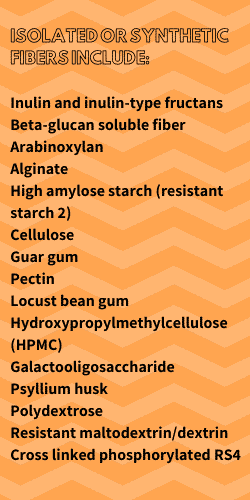
By Rosanne Rust, MS, RDN, LDN —

Fiber is an important dietary component. It serves both the food industry as a functional additive, and also provides benefits to human health. When you think of fiber, you may think of naturally occurring fibers that add “bulk” to the diet (foods like whole grains, cereals, fruits, and vegetables). In reality, fruits and vegetables provide small amounts of fiber, and to meet the recommendation for daily fiber (about 25 grams per day), you must include whole grains as well as other foods that contain fiber.
There are also a wide variety of naturally-derived fibers, as well as synthetic ones, that can have a positive impact on health. Natural fibers are those from whole fruits, vegetables and grains, or derived from them. In addition to natural fibers, food processors use isolated or synthetic non-digestible soluble and insoluble carbohydrates which have similar physiological effects, and therefore are classified as fiber.
The FDA established a definition for dietary fiber in 2016, and it is continually updated as new ingredients come into the market that have the functional benefits of fiber. Natural fibers are considered “intact fibers” because they haven’t been removed from the food. Isolated or synthetic non-digestible fibers are sometimes added to foods to reap the same health benefits as natural fibers. All of these types of fiber are included on the Nutrition Facts label.
According to FDA regulation,
“Dietary fiber that can be declared on the Nutrition and Supplement Facts labels includes certain naturally occurring fibers that are “intrinsic and intact” in plants, and added isolated or synthetic non-digestible soluble and insoluble carbohydrates that FDA has determined have beneficial physiological effects to human health.”
If any of these non-digestible fibers has at least one of the following health impacts, it can be considered a dietary fiber on the Nutrition Facts Label:

There are many physiological effects of fiber that benefit health. They help maintain gut health by offering “food” for the gut’s microbes (these are prebiotic fibers), as well as bulk for proper bowel movements. Prebiotic fibers include the non digestible part of foods like bananas, onions and garlic, Jerusalem artichoke, the skin of apples, chicory root, or beans. They move through the small intestine undigested and are fermented in the colon. It’s the fermentation process that feeds beneficial “good” bacteria (including probiotic bacteria), helping our digestive systems.
Fiber can also aid weight management, as a diet high in fiber slows motility and helps maintain feeling of fullness. Many soluble fibers also plays a role in lowering LDL and cholesterol and can help people with diabetes manage blood sugar.
In addition to the health benefits, some fibers play a functional role in food processing, providing several benefits as a sugar replacer and bulking agent, as well as a humectant (keeping products moist and fresh). Fiber can be broken into two categories: Soluble and Insoluble.
Chicory Root Inulin. Inulin is a naturally occurring fermentable fiber from chicory root. It can also be manufactured from sucrose and fructose using an enzymatic process. Including it in the diet may help enhance calcium absorption, improve bone mineral density, serve as a probiotic, help with laxation and normal bowel function, stabilize blood glucose, and support the immune system.
Galacto-oligosaccharide. This is a synthetic polymer synthesized from enzymatic treatment of lactose. It also helps increase calcium absorption and acts as a prebiotic.
Dextrin. Also called resistant maltodextrin, this synthetic polymer corn fiber has several benefits including enhanced calcium absorption, bone formation, helps maintain healthy blood glucose levels, helps maintain bowel function and helps maintain healthy triglyceride levels.
Polydextrose. A synthetic polymer that can help with satiety, acts as a prebiotic, maintain healthy bowel function, acts as a prebiotic, and can stabilize blood sugars after a carbohydrate rich meal.
Beta Glucan. It’s naturally occurring in oats and barley and can help stabilize blood cholesterol levels, reducing the risk of heat disease, and also can stabilize blood glucose levels.
Guar Gum. This fiber originates from the seed of the guar plant. It can help stablize cholesterol and glucose levels, modify gastrointestinal conditions, and acts as a prebiotic, helping to maintain a healthy gut.
Locust Bean Gum. From the seed of the locust bean tree, this fiber also helps maintain healthy blood cholesterol levels.
Hydroxypropylmethylcellulose (HPMC). This is a cellulose derived from vegetables. It can help normalize blood cholesterol and glucose levels.
Psyllium (Psyllium husk, psyllium seed husk). This fiber promotes laxation, reduces cholesterol levels, helps maintain healthy bowel function, and acts as a prebiotic.
Pectin. Is naturally found in the cell walls and tissues of fruits and vegetables (apples, pears, plums, oranges, guava. Cherries, grapes and berries have smaller amounts). It helps lower cholesterol and helps maintain normal glucose levels. It may also help with diarrhea as it slows the passage of food through the intestine.
Cellulose. This naturally occurring plant fiber that helps lower cholesterol and glucose levels.
High Amylose Starch. This resistant starch is extracted from potatoes, corn, and bananas. It promotes increased sensitivity to insulin, helping stabilize post-prandial insulin and glucose levels. It also can help maintain healthy bowel function.
Arabinoxylan. This is a naturally occurring fiber found in the walls of cereal grains, and can help stabilize insulin and blood glucose levels.
Alginate. Extracted from brown seaweed, this fiber can help maintain digestive health, stabilize blood glucose and cholesterol, and acts as a prebiotic fiber.
As you educate patients to include more fiber in the diet, advise them to read the Nutrition Facts Panel for fiber. Including a variety of both fresh and packaged high fiber foods can help meet dietary fiber goals. While some of these ingredients may have “names you can’t pronounce” on the ingredient label, or are synthetically derived, keep in mind that they have important properties that can support gut health, heart health, or help manage diabetes.
References:
Questions and answers for industry on dietary fiber. US Food and
Drug Administration website. https://www.fda.gov/food/food-labeling-nutrition/questions-and-answers-dietary-fiber
Petition for review https://www.fda.gov/food/cfsan-constituent-updates/fda-grants-citizen-petition-dietary-fiber
The post The Bountiful Benefits of Fiber appeared first on Fiber Facts.